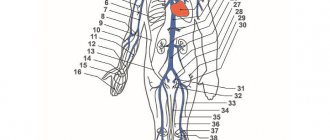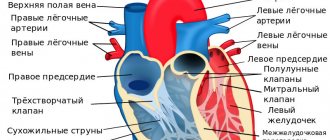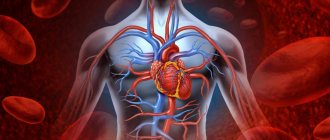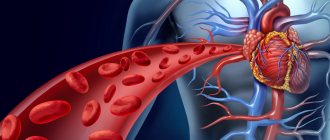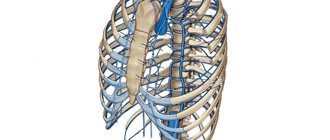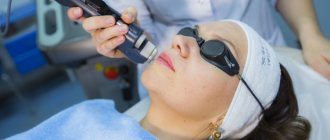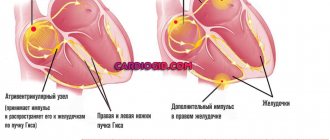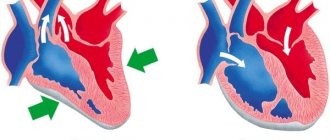What it is
Translated from Latin, capillaris means “hairy.” These are the thinnest elastic vessels in the human body, the average diameter of which does not exceed 10-11 microns. The length varies from 0.05 µm to 1 mm.
They are found in all tissues and organs of the human body and are responsible for the metabolism between tissues and blood.
There are more than 40 billion vessels in the human body, the total length of which is about 100,000 km. The exchange surface area is 1000 m2.
Cuperosis on the face: how to get rid of closely spaced vessels
Wednesday, November 04, 2020 11:39 + to quote book
Redness on the face can be associated not only with teenage problems. One of the causes of local red spots is the early stage of rosacea, and if individual spider veins and capillaries, and sometimes entire networks, are visible, then this is an alarm bell to urgently begin skin treatment. Typically, rosacea on the face appears in those places where the skin is thinnest - on the wings of the nose and bridge of the nose, cheekbones, cheeks and in the area around the eyes. But it can also appear in completely unexpected places if the condition of the blood vessels is too advanced or the skin has been subjected to intense exposure, as a result of which it has become thinner.
In my case, rosacea has three causes: a genetic predisposition with light, thin skin, incorrect selection of acid cosmetics and an unsuccessful ultrasonic facial cleansing procedure. All this led to the fact that the inconspicuous pink spots at the wings of the nose grew into subtle threads of capillaries that were still barely noticeable. Now, when I’m only 27, they can still be easily disguised with makeup, but there is a predisposition and a high probability that another star can pop up anywhere. I decided to take control of the problem and study the topic thoroughly.
Is it possible to cure rosacea once and for all, or at least how to strengthen the blood vessels on the face so that they are not so noticeable?
Are there medicinal cosmetics for rosacea and how to choose care for rosacea skin in the early stages? We'll figure out.
Quickly and briefly or slowly and forever?
As with varicose veins, some damaged capillaries on the face can be removed with a laser. In some cases, this is the only way to prevent rosacea from developing into a more severe form - rosacea. But in my case it’s expensive, scary and not relevant because there are no serious problems. In general, I think that radical surgical intervention in the body’s activity should be performed only in the most serious cases, if possible making do with less radical therapy and comprehensive prevention. And to do this, you need to understand how and why you got into the risk zone.
Causes of rosacea
:
– Age-related changes and local thinning of the skin
– Photoaging due to UVA solar activity
– Hormonal changes and changes in the body
– Inflammatory processes of the cardiovascular system
– Liver dysfunction
- First, you need to get rid of or reduce the influence of negative factors. In my case, this is a must for proper nutrition to reduce the load on the liver. Plus, nutrition should be moderate, taking into account the cardiovascular system and my personal heart problems. Apparently, vegetarianism is inevitable.
- Secondly, you need to select cosmetics for rosacea so that prevention is included in your daily care program. This way, all procedures and treatment will be regular, familiar and as long as possible without interruption from everyday activities.
- Thirdly, it is worth thinking about supporting the body from the inside - collagen, vitamins, antioxidants, venotonics and a number of other dietary supplements that can improve the condition of the vascular walls and facial skin.
How to get rid of rosacea on the face at home?
Once I went for an ultrasonic facial cleansing and the cometologist girl started cleaning my nose with such frenzy that in the end, after the procedure, it ended up covered in scratches. After this sadism, the stars on the wings of my nose intensified, and I became paranoid about salons in general. Therefore, I began to select a care system with the possibility of independent use at home.
Compresses with iced tea or brewed chamomile do not make me smile. Thank God we don’t live in a dark age and medicinal cosmetics for rosacea have existed for a long time. It will not remove broken capillaries, but it will help remove redness, make the spider veins less noticeable, and most importantly, it will work on thickening the skin. The principle of operation of any cream for rosacea on the face is very simple - to lift the top layer of skin above the circulatory system as much as possible, thereby hiding the capillaries. This is an effective program not only for rosacea, but also as an anti-aging course in general.
Stages of care for couperose skin
Step 1: Gentle Cleansing
. Even for problematic, oily and active skin, you will have to choose a delicate cleansing with a neutral PH - to remove impurities, but maintain the natural balance of the skin. No sudden changes in water temperature, use masks only locally, especially when it comes to acids, peelings and clay. No facial brushes or scrubbing particles in the area of rosacea. The ideal option is contactless foam washing.
Characteristics and types
They have three-layer walls. The inner layer consists of endothelial cells located on the basement membrane. Pericytes form the middle layer and are located in the “pockets” of the membrane.
They are elongated cells with processes. Each process is connected to endothelial cells and is responsible for transmitting impulses to the latter. Adventitial cells and connective tissue elements with included collagen fibers form the outer layer.
Depending on the structure, there are types of capillaries:
- Somatic or continuous. The walls of the capillary consist of endothelium and membrane located in a continuous layer. They have low throughput. Found in connective tissues, tissues of the muscular and nervous systems, and exocrine glands.
- Visceral or fenestrated. The endothelial layer contains “fenestrae” - small slit-like pores. Fenestrae are evenly spaced along the entire length and occupy up to 30% of the area. The visceral type is characteristic of the glands of external and internal secretion, the gastrointestinal tract, and the kidneys.
- Sine wave or intermittent. Characterized by the presence of large holes (sinuses) in the endothelial layer and the discontinuous structure of the basement membrane in the area of the holes. The permeability of capillaries to fluid, proteins and blood cells is high. Sinusoidal vessels are found in the liver, spleen, and hematopoietic organs.
By lumen diameter:
- narrow – 3-7 microns;
- wide - 8-15 microns;
- sinusoidal – 16-30 µm;
- lacunae – more than 30 microns.
According to functional features they are distinguished:
- main – directly connect arterioles and venules;
- nutritive - branch from the arterial end and flow into the venous end, forming a capillary network. Smaller lumen diameter.
Structure and dimensions of capillaries
These small vessels have approximately equal diameters in different organs. The larger ones reach a lumen of up to 30 microns, and the narrowest ones - from 5 microns. It is easy to see that wide blood capillaries in cross-sections in the lumen of the tube are lined with several layers of endothelial cells, while the lumen of the smallest ones is formed by a layer of only one or two cells. Such thin vessels are located in muscles that have a striated structure, and since their diameter is smaller than that of red blood cells, the latter experience significant deformation when passing through a narrow bloodstream.
A capillary is such a thin tube that its wall, consisting of individual endothelial cells that are in close contact with each other, does not have a muscle layer and therefore is not able to contract. The capillary network usually contains only 25% of the blood volume that it can accommodate. But changes in these volumes can be achieved when the self-regulation mechanism is turned on, when the smooth muscle cells are relaxed.
Main functions
The main function is the exchange of substances between tissue and blood. Water and substances dissolved in the blood plasma enter the intercellular space. From there, the substances are absorbed by tissue cells.
The breakdown products of substances and carbon dioxide from the cells return to the capillaries, from there to the venules, veins and heart.
The endothelium forms the walls of capillaries and is responsible for functions such as:
- Transport - metabolism, gas exchange between blood and tissue cells, transfer of signal substances and hormones.
- Production of procoagulants and anticoagulants responsible for blood clotting.
- Production of substances that regulate hematopoiesis - mitogens, cytokines.
- Participation in the immune response mechanism. Receptor molecules on the surface of the endothelium trap immune cells and promote their further movement to the site of infection or damage.
Removing capillaries at home
Professional treatment and removal are effective, but quite expensive. Also, these procedures should not be attended during pregnancy and lactation, but it is at this time that the skin is most susceptible to rosacea. And if you can’t go to a cosmetologist yet, then try removing capillaries with folk remedies.
Mask made from Ascorutin tablets and green tea
This mask is best done after washing your face in the evening before going to bed, using the following recipe:
- add 2 crushed Ascorutin tablets to 50-100 ml of green tea;
- add white clay to the composition.
- Apply the resulting mask to your face for about 20 minutes. The procedure should be repeated 2-3 times a week, alternating it with massage.
Oat flour
For this product you will need 1 tbsp. l. oatmeal and the same amount of chopped chamomile, rosemary or cypress. Dry raw materials must be filled with 1-2 tbsp. l. oils, mix and apply to face. The duration of the procedure is 15 minutes.
Oil based mask
For this remedy, take 1 tbsp. l. milk thistle or calendula oils, then add 2-3 drops of mint, lemon or lavender essential oil. Warm the mixture and rub into the skin during a massage. This nourishing composition does not need to be washed off, and if you decide to wash your face, be sure to use a nourishing or healing cream.
How to remove capillaries on the face using starch?
Starch effectively treats broken capillaries, so you should definitely use it for home treatment. For example, a mask made from grated potatoes, which should be applied to the skin for 15 minutes, helps well against dilated blood vessels. A product based on dry starch is also effective:
- several fresh sea buckthorn berries, strawberries and raspberries should be crushed with a fork;
- to the berries you need to add 1 tbsp. l. starch and mix the product again;
- Leave the composition on the skin for a quarter of an hour.
After the procedure, wipe your face with a weak chamomile decoction, which will moisturize the skin and cleanse it.
Advice! Take 100 ml of a weak chamomile decoction and add 2-3 tbsp. l. potato starch. The mask should be left on the skin for at least 15 minutes.
What doctors treat
If pathology is suspected, you should first contact a neurologist. This is a doctor whose competence is to eliminate circulatory disorders, further treatment and diagnosis.
If treatment requires the intervention of doctors of a narrower profile, the neurologist will issue a referral for further examination.
The most common vascular disease is varicose veins of the lower extremities. A phlebologist is a specialized specialist who specializes in the diagnosis and treatment of varicose veins, venules and capillaries.
If there is tingling in the extremities, pain or impaired mobility, you should see an angiologist. The field of activity of an angiologist is pathology of the arteries and lymphatic system.
The composition of the blood, thrombus formation and inflammation will be determined by a hematologist.
Treatment of closely located vessels and capillaries on the face
If a pink or bluish mesh of tiny blood vessels appears on the skin of the face, this indicates the vascular disease rosacea. This is not just a cosmetic defect that provokes a change in the color of the skin on the face, but also a serious pathology, which is accompanied by a disruption in the nutrition of the deep layers of the dermis at the site of damage. Treatment of closely located vessels is carried out using hardware techniques, proper nutrition, taking vitamins, minerals, and immunostimulants.
Possible diseases
The main symptoms, the appearance of which should alert you, are the appearance of networks, nodules, hematomas or asterisks on the surface of the skin. The risk group includes people who are often under stress, overweight and bad habits - smoking, drinking alcohol.
The likelihood of pathologies also increases with constant intense physical activity. This is typical for people whose working day is spent on their feet.
Spasm of the walls
Leads to stagnation of blood in a certain area and to inflammatory processes. Narrowing of the vessels of the upper extremities leads to numbness of the hand, fingers, and impaired motor function.
Spasm of cerebral vessels causes dizziness and migraine, and initiates ischemia. Stagnation of blood in the uterus in pregnant women provokes eclampsia.
Capillary varicose veins
A symptom of pathology is a hematoma, mesh or stars appearing on the surface of the skin. With this disease, the blood vessels dilate and the walls become inflamed. With the protracted nature of the disease, the blood vessels begin to burst.
Causes of the pathology: thinning of the walls, excessive physical activity, lack of platelets, trauma, genetic predisposition.
Capillarotoxicosis
Other names are hemorrhagic vasculitis, allergic purpura, Henoch-Schönlein disease. It is a violation of the permeability of capillary walls, increasing their fragility. Provokes inflammatory processes in blood vessels.
In some cases, it occurs with multiple formation of blood clots.
The disease begins with the appearance of hematomas and bruises at the site of hemorrhage, disruption of the genitourinary system and gastrointestinal tract.
It occurs due to the intense effect of a complex of proteins on the blood vessels. In response, the immune defense reacts with increased release of antibodies. The resulting “agent-antibody” complex has a destructive effect on the walls and also leads to thrombus formation.
They provoke pathology: viral and bacterial infections, hypothermia, deep injuries, allergies.
Pathologies
Despite the ultra-small diameter and fairly low blood pressure inside the capillaries, they, like larger vessels, are subject to stretching, resulting in the development of capillary varicose veins. This pathology is considered the most common and is diagnosed mainly in pregnant women. It is expressed by the appearance of bluish “stars”, around which hematomas may appear. The condition can be complicated by inflammation, accompanied by pain and swelling of the affected area.
The second most common problem of the smallest vessels is spasm of their walls. Since there is no muscle layer in these vessels, the pathology is considered to be a consequence of excessive load on the muscles, in the thickness of which the capillary network lies. The narrowing of superficial vessels leads to pale skin and a feeling of numbness. When there is a spasm of the capillary network of internal organs, the symptoms depend on the localization of the process:
- when the tubes in the brain narrow, migraines, dizziness occur, vision, hearing or memory are impaired;
- with spasm of capillaries in the uterus, a condition of pre-eclampsia occurs;
- When the blood vessels in the intestines narrow, colic, spasms, and symptoms of dyspepsia are observed.
The least common disease of the capillary network is capillary toxicosis or hemorrhagic vasculitis. It is accompanied by increased fragility of capillaries and the formation of numerous blood clots in them. The pathological focus can be located both on the surface of the body and on the internal organs. The main cause of the disease is considered to be infection of the circulatory system by viruses and bacteria. In some cases, the disease occurs due to deep trauma or hypothermia.
Diagnostic methods
When diagnosing diseases such as atherosclerosis, hypertension, vasospasm, diabetes mellitus, small vessels are examined. Diagnostic methods are divided into non-invasive and invasive.
There are two non-invasive diagnostic methods: capillaroscopy and conjunctival biomicroscopy.
The essence of the first is to study the vascular network in a small intact area under a microscope or capillaroscope. Most often, the object of diagnosis is the nail bed. During the study, the shape and number of blood vessels and the movement of blood through them are studied.
Narrowing or deformation of the walls, as well as an increase or decrease in the number of capillaries indicates the presence of a disease.
The second method is used to identify pathologies of the vessels of the eyeball. The study is carried out using a microscope with special illumination.
Invasive methods consist of studying blood parameters. Capillary blood is a diagnostic material that is taken from a finger for analysis. For this purpose, a general and detailed biochemical analysis is performed.
Looking in the mirror
Very often, looking at your reflection in the mirror, you can see small threads on your face - red capillaries that were not there before. Many are frightened, mistaking their appearance for symptoms of dangerous diseases. According to statistics, 80% of the entire population experience such changes when dilated capillaries become visible through the skin. First of all, this indicates that the normal functioning of the blood vessels is impaired. And although the expansion of capillaries in itself does not cause any particular harm to health, it can worsen the appearance. Vascular networks on the face - rosacea - are a manifestation of the disease, its rather harmless stage, but they serve as signals of problems in the body.
Proper care for vascular skin with dilated capillaries
Couperose skin is, first of all, very sensitive, even hypersensitive skin, which reacts with irritation to any external factors.
Skin with thin blood vessels requires increased attention, since lack of proper care can lead to the development of a serious disease, which is rosacea.
It is important to know all possible methods of care and prevention.
Why there is a problem with blood vessels in the skin
The problem of dilated capillaries, especially on the face, mainly affects women, whose hormone estrogen causes increased vasodilation.
Vascular hypersensitivity appears already during puberty, and can appear on the surface of any skin, both dry or mixed, and oily.
Such skin needs increased attention and more thorough care, since neglect can lead to inflammation and, consequently, to the development of rosacea.
There can be many reasons for the formation of vascular networks.
This is, first of all, a genetic predisposition, a disorder of the structure of blood vessels, as well as hormonal disorders, mainly associated with an increased amount of estrogen in the body.
Telangiectasia, or persistently enlarged blood vessels, is also a symptom of skin diseases such as rosacea or lupus erythematosus. Accompanied by arterial hypertension and the use of steroid drugs.
Excessive vasodilatation and visible mesh on the skin are most often caused by external factors such as temperature fluctuations and excessive exposure to UV radiation. Many of these factors can overlap.
It is difficult to independently determine changes in the structure of the capillaries; in each case it may look a little different. Sometimes the vessels have the shape of stars or straight lines, and may appear in spots. So keep an eye on your skin so that you can choose a personalized care plan for it.
What contributes to the appearance of rosacea?
Skin with enlarged capillaries and recurrent erythema is a problem that affects many people. Not everyone can take care of this properly. Reduce your exposure to external factors and take preventative measures to keep your skin healthy.
Skin with dilated capillaries is, first of all, very sensitive skin that reacts with redness to various types of irritants, for example:
- UV radiation.
- Wind, frost, temperature fluctuations, heat.
- Hot dishes, hot, spicy spices.
- Alcohol and cigarettes.
- Stress.
Redness that appears at the beginning develops over time. Dilated blood vessels become noticeable on the face. Such changes most often appear in the cheeks, chin and nose, as well as above the upper lip.
How to properly care for skin with dilated capillaries
Caring for such a unique skin type must be comprehensive. This requires a certain regime and self-discipline.
First of all, avoid stimulants such as alcohol and cigarettes, as well as spicy and hot foods.
Do not cleanse your skin with hot water, menthol soap, certain oils (such as eucalyptus), scented fragrances, chlorinated water, and all types of strong astringent or irritating cosmetics.
Do not use granular peels, expose your skin to sunlight or use a tanning bed. The sauna is also not recommended. Avoid stress and sudden changes in temperature, as well as increased physical activity. It is important to eat a diet rich in vegetables and fruits.
Skin with thin capillaries should be washed with warm water, handling it extremely delicately to avoid mechanical damage.
It is important to use cosmetic preparations intended specifically for such skin - creams, tonics or serums that will not irritate it (remember that this is hypersensitive skin), and which contain substances that tighten and constrict blood vessels.
It is best to give preference to pharmacy cosmetics that do not contain parabens, fragrances and other similar substances. Try to choose natural cosmetics based on herbal ingredients - they are safer for the skin and have a more delicate effect on it.
For this skin type, enzyme peels will be effective, which do not stimulate blood circulation and at the same time exfoliate dead cells. It is imperative, regardless of the season, to use SPF and PA filters to protect the skin from radiation.
Use the right creams. Oral medications designed to seal blood vessels from the inside also deserve attention.
An excellent care product is hydrolates, which have almost the same properties as oils, but act more gently and are suitable even for very sensitive skin.
They nourish and moisturize it, relieve flaking and dryness, narrow capillaries and reduce the vascular network on the face.
Couperose skin before and after care
Vascular network on the face: the best cream for capricious skin
There are many substances that are effective for caring for couperose skin. They are designed to prevent inflammation, strengthen blood vessels and increase their tone, as well as eliminate existing problems. They also hydrate and protect the skin from external factors such as radiation or temperature changes. These substances include:
- Hesperidin is a flavonoid found in citrus fruits that reduces the permeability of blood vessels.
- Diosmin is a flavonoid that seals blood vessels, increases their tone, has an anti-inflammatory effect, improves lymph circulation and thus has an anti-edematous effect.
- Rutin – has sealing properties of blood vessels, enhances the effect of vitamin C and is often used in combination with it.
- Vitamin C – improves skin immunity, stimulates collagen synthesis, tightens blood vessels and accelerates their healing.
- Horse chestnut - tightens and tones the walls of blood vessels, eliminates swelling and improves blood circulation.
- Violet tricolor - seals blood vessels, regulates metabolism in cells, has an anti-inflammatory and bactericidal effect.
- Barbiturate – reduces vascular permeability, improves blood circulation, moisturizes and heals.
- D-panthenol – soothes irritations and moisturizes the skin.
- Mountain arnica – tightens and constricts blood vessels, relieves inflammation.
- Witch hazel (witch hazel) – contains tannins and flavonoids, tightens blood vessels, improves blood circulation and prevents inflammation, also has an antibacterial effect.
- Bisabolol (chamomile extract) – has anti-inflammatory and antibacterial effects, soothes irritated skin, facilitates healing and prevents inflammation.
- Vitamin K - helps heal wounds, regulates blood clotting processes, improves skin color.
- Allantoin – heals, has an anti-inflammatory effect, moisturizes the skin.
Treatment of dilated capillaries on the face
If blood vessels cannot be treated with home methods, it is recommended to visit a beauty salon. Modern cosmetology and aesthetic medicine offer a number of procedures that remove vascular network on the face. Here are some of them:
- Electrocoagulation is a non-invasive tissue coagulation with high-frequency current.
- Laser therapy – under the influence of a laser beam, thermal coagulation of the lumen of the vessel occurs.
- IPL (Intense Pulsed Light) is a modern method of using light waves that cause vascular thermolysis.
These are just three of many methods. All of them give excellent results and help get rid of the unpleasant vascular network on the face. Iontophoresis is also used as an auxiliary treatment, in which sealing substances are injected under the skin and a lamp with a blue Sollux filter is used, which soothes the vascular system and relieves irritation.
Electrocoagulation
Remember that skin with fragile blood vessels requires maximum attention and careful care, and negligence in this regard can lead to the development of a serious disease - rosacea. It is important to know all possible methods of care and prevention. Remember that we do this not only for beauty, but also for health!
We recommend:
TOP skin care mistakes that women make most often
Moisturizing facial skin
8 effective folk remedies to remove puffy eyes
HERE you will find more useful information about facial care.
Source: //kaliopa.ru/uxod-za-licom/uhod-za-kozhey/kak-uhazhivat-za-kozhey-s-rashirnnyimi-kapillyarami.html

